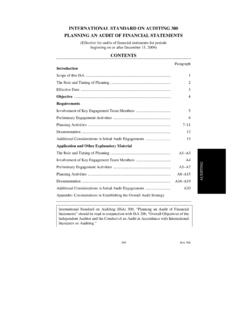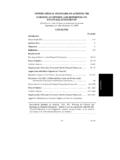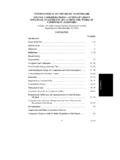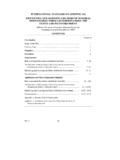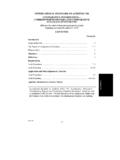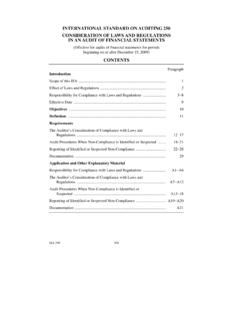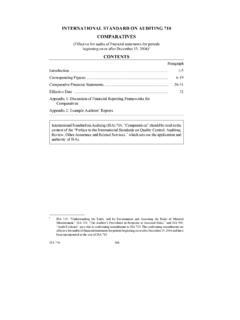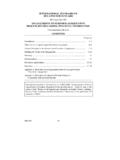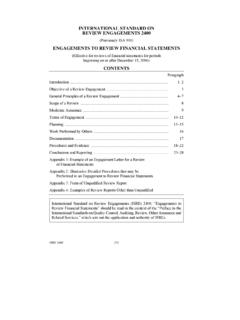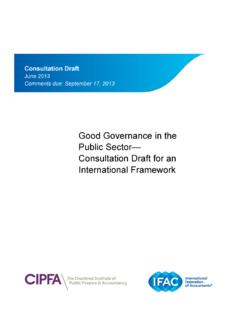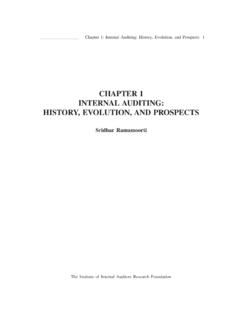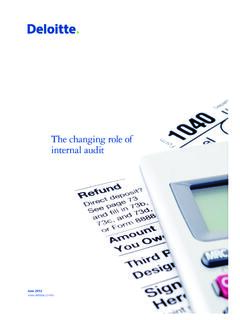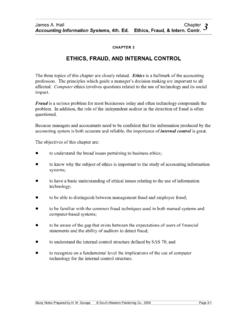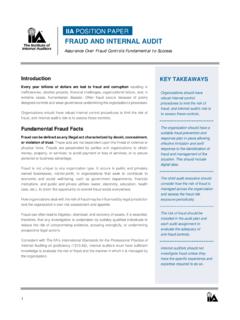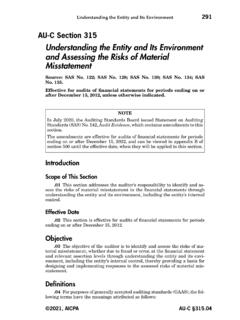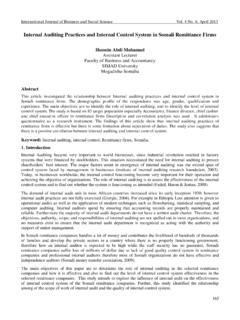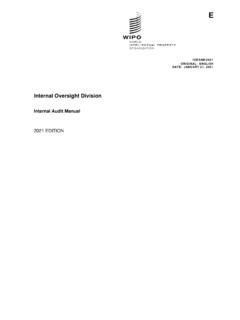Transcription of INTERNATIONAL STANDARD ON AUDITING 240 THE …
1 ISA 240 267 AUDITING INTERNATIONAL STANDARD ON AUDITING 240 THE AUDITOR S RESPONSIBILITY TO CONSIDER fraud IN AN AUDIT OF FINANCIAL STATEMENTS (Effective for audits of financial statements for periods beginning on or after December 15, 2004) CONTENTS Paragraph Introduction .. 1-3 Characteristics of fraud .. 4-12 Responsibilities of Those Charged with Governance and of Management .. 13-16 Inherent Limitations of an Audit in the Context of fraud .. 17-20 Responsibilities of the Auditor for Detecting Material Misstatement Due to fraud .
2 21-22 Professional Skepticism .. 23- 26 Discussion Among the Engagement Team .. 27-32 Risk Assessment Procedures .. 33-56 Identification and Assessment of the Risks of Material Misstatement Due to fraud .. 57-60 Responses to the Risks of Material Misstatement Due to fraud .. 61-82 Evaluation of Audit Evidence .. 83-89 Management Representations .. 90-92 Communications with Management and Those Charged with Governance .. 93-101 Communications to Regulatory and Enforcement Authorities.
3 102 Auditor Unable to Continue the Engagement .. 103-106 Documentation .. 107-111 Effective Date .. 112 The IAASB s clarity drafting conventions have been applied to ISA 240. ISA 240 (Redrafted), The Auditor s Responsibilities Relating to fraud in an Audit of Financial Statements can be found in Part II of the Handbook of INTERNATIONAL AUDITING , Assurance, and Ethics Pronouncements. It is effective for audits of financial statements for periods beginning on or after December 15, 2009.
4 THE AUDITOR S RESPONSIBILITY TO CONSIDER fraud IN AN AUDIT OF FINANCIAL STATEMENTS ISA 240 268 Appendix 1: Examples of fraud Risk Factors Appendix 2: Examples of Possible Audit Procedures to Address the Assessed Risks of Material Misstatement Due to fraud Appendix 3: Examples of Circumstances that Indicate the Possibility of fraud INTERNATIONAL STANDARD on AUDITING (ISA) 240, The Auditor s Responsibility to Consider fraud in an Audit of Financial Statements, should be read in the context of the Preface to the INTERNATIONAL Standards on Quality Control, AUDITING , Review, Other Assurance and Related Services, which sets out the application and authority of ISAs.
5 THE AUDITOR S RESPONSIBILITY TO CONSIDER fraud IN AN AUDIT OF FINANCIAL STATEMENTS ISA 240 269 AUDITING Introduction 1. The purpose of this INTERNATIONAL STANDARD on AUDITING (ISA) is to establish standards and provide guidance on the auditor s responsibility to consider fraud in an audit of financial statements1 and expand on how the standards and guidance in ISA 315, Understanding the Entity and its Environment and Assessing the Risks of Material Misstatement and ISA 330, The Auditor s Procedures in Response to Assessed Risks are to be applied in relation to the risks of material misstatement due to fraud .
6 The standards and guidance in this ISA are intended to be integrated into the overall audit process. 2. This STANDARD : Distinguishes fraud from error and describes the two types of fraud that are relevant to the auditor, that is, misstatements resulting from misappropriation of assets and misstatements resulting from fraudulent financial reporting; describes the respective responsibilities of those charged with governance and the management of the entity for the prevention and detection of fraud , describes the inherent limitations of an audit in the context of fraud , and sets out the responsibilities of the auditor for detecting material misstatements due to fraud .
7 Requires the auditor to maintain an attitude of professional skepticism recognizing the possibility that a material misstatement due to fraud could exist, notwithstanding the auditor s past experience with the entity about the honesty and integrity of management and those charged with governance; Requires members of the engagement team to discuss the susceptibility of the entity s financial statements to material misstatement due to fraud and requires the engagement partner to consider which matters are to be communicated to members of the engagement team not involved in the discussion; Requires the auditor to: Perform procedures to obtain information that is used to identify the risks of material misstatement due to fraud .
8 Identify and assess the risks of material misstatement due to fraud at the financial statement level and the assertion level; and for those assessed risks that could result in a material misstatement due to fraud , evaluate the design of the entity s related controls, including relevant control activities, and to determine whether they have been implemented; 1 The auditor s responsibility to consider laws and regulations in an audit of financial statements is established in ISA 250, Consideration of Laws and Regulations in an Audit of Financial Statements.
9 THE AUDITOR S RESPONSIBILITY TO CONSIDER fraud IN AN AUDIT OF FINANCIAL STATEMENTS ISA 240 270 Determine overall responses to address the risks of material misstatement due to fraud at the financial statement level and consider the assignment and supervision of personnel; consider the accounting policies used by the entity and incorporate an element of unpredictability in the selection of the nature, timing and extent of the audit procedures to be performed; Design and perform audit procedures to respond to the risk of management override of controls; Determine responses to address the assessed risks of material misstatement due to fraud ; Consider whether an identified misstatement may be indicative of fraud ; Obtain written representations from management relating to fraud ; and Communicate with management and those charged with governance.
10 Provides guidance on communications with regulatory and enforcement authorities; Provides guidance if, as a result of a misstatement resulting from fraud or suspected fraud , the auditor encounters exceptional circumstances that bring into question the auditor s ability to continue performing the audit; and Establishes documentation requirements. 3. In planning and performing the audit to reduce audit risk to an acceptably low level, the auditor should consider the risks of material misstatements in the financial statements due to fraud .
